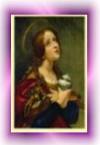Fine Art vs Icons; what's the difference?
Fine Art vs Icons; what's the difference?
Devotion to the souls in Purgatory contains in itself all the works of mercy, which supernaturalized by a spirit of faith, should merit us Heaven. de Sales
Re: Fine Art vs Icons; what's the difference?
interestingly, an iconographer does not "paint" an icon....they say they "write" an icon
I was privileged to be invited to witness an iconography exhibition.
They use real gold in the paint.....hence why they are so expensive
extraordinary to watch evolve
One can look for very minute tell-tale signs hinting clues of the story and encounter.
I was privileged to be invited to witness an iconography exhibition.
They use real gold in the paint.....hence why they are so expensive
extraordinary to watch evolve
One can look for very minute tell-tale signs hinting clues of the story and encounter.
"He who followeth Me, walketh not in darkness." sayeth the Lord
Re: Fine Art vs Icons; what's the difference?
Beautiful Icon with description.

Copied from a Ukranian Church in Canada:
One of the most popular icons found in Ukrainian churches and homes falls into the Eleusa category. It is known by several names, including the “Virgin of Passion”, the “Virgin of Perpetual Help” or Pammakaristos in Greek. Some Ukrainians may know it as the Dostoino icon because the icon commemorates the Hymn to the Theotokos: “It is truly meet to bless you, Theotokos, ever blessed and most pure and Mother of our God.” The first word of this hymn in Slavonic is Dostoino (Достóйно).
One must study the details of the icon to appreciate why it is called the “Virgin of Passion”. The theological interpretation of this icon is that the angel who greeted the Virgin at the Annunciation now reveals the instruments of the Passion to her and her child. Christ, being a human child, is frightened by this revelation. The two angels in the upper corners bear the implements of Christ’s torture and death. Note that one of the sandals is loose and dangles freely from Jesus’ foot. Tradition has it that the sandal came off when Christ was frightened by the vision presented by the angels and he leapt into his mother’s arms. (In some versions of this icon the Virgin and Child wear crowns and in others they do not.)
Copied from a Ukranian Church in Canada:
One of the most popular icons found in Ukrainian churches and homes falls into the Eleusa category. It is known by several names, including the “Virgin of Passion”, the “Virgin of Perpetual Help” or Pammakaristos in Greek. Some Ukrainians may know it as the Dostoino icon because the icon commemorates the Hymn to the Theotokos: “It is truly meet to bless you, Theotokos, ever blessed and most pure and Mother of our God.” The first word of this hymn in Slavonic is Dostoino (Достóйно).
One must study the details of the icon to appreciate why it is called the “Virgin of Passion”. The theological interpretation of this icon is that the angel who greeted the Virgin at the Annunciation now reveals the instruments of the Passion to her and her child. Christ, being a human child, is frightened by this revelation. The two angels in the upper corners bear the implements of Christ’s torture and death. Note that one of the sandals is loose and dangles freely from Jesus’ foot. Tradition has it that the sandal came off when Christ was frightened by the vision presented by the angels and he leapt into his mother’s arms. (In some versions of this icon the Virgin and Child wear crowns and in others they do not.)
Devotion to the souls in Purgatory contains in itself all the works of mercy, which supernaturalized by a spirit of faith, should merit us Heaven. de Sales
